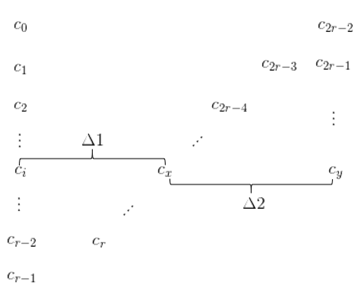The string "PAYPALISHIRING" is written in a zigzag pattern on a given number of rows like this: (you may want to display this pattern in a fixed font for better legibility)
P A H N A P L S I I G Y I RAnd then read line by line:
"PAHNAPLSIIGYIR"
Write the code that will take a string and make this conversion given a number of rows:
string convert(string text, int nRows);
convert("PAYPALISHIRING", 3) should return
"PAHNAPLSIIGYIR".
---------------------------------------------------------------------------------------------------
思路:
我们先来定义符号:设原字符串中的第一个字符为 

之字形的第一个周期的示意图如下:
其中,

显然地,对于某一行i,每个周期中的

显然,

所以,只需要从第0行开始,一直打印到第r-1行即可。
不过,做算法题一定要注意边界值。
首先,对于第0行和第r - 1行,每个周期只用输出一次,要在代码中进行判断,防止重复输出。另外,
对于这道题而言,r = 1是一个很特殊的边界输入。当r=1时,i必然为0,则此时
-----------------------------------------------------------------------------
代码:
class Solution {
public String convert(String s, int numRows) {
int r = numRows, n = s.length();
if(r == 1) return s;
StringBuilder sb = new StringBuilder(n);
for(int i=0;i<r;i++){
int d1 = 2*r - 2*i - 2;
int d2 = 2*i;
for(int j=i;j<n;){
if(i != r-1) {
sb.append(s.charAt(j));
j += d1;
}
if(i != 0 && j < n) {
sb.append(s.charAt(j));
j += d2;
}
}
}
return sb.toString();
}
}


























 373
373

 被折叠的 条评论
为什么被折叠?
被折叠的 条评论
为什么被折叠?








